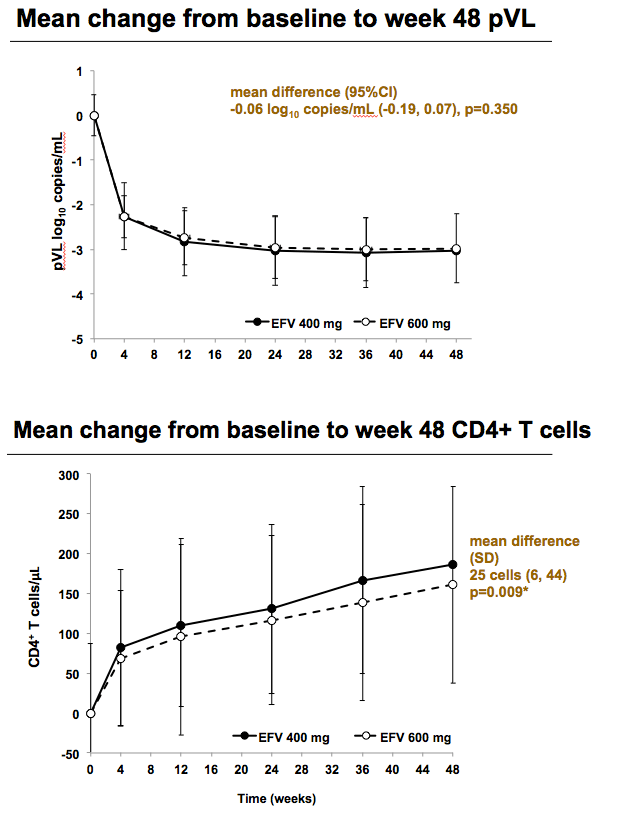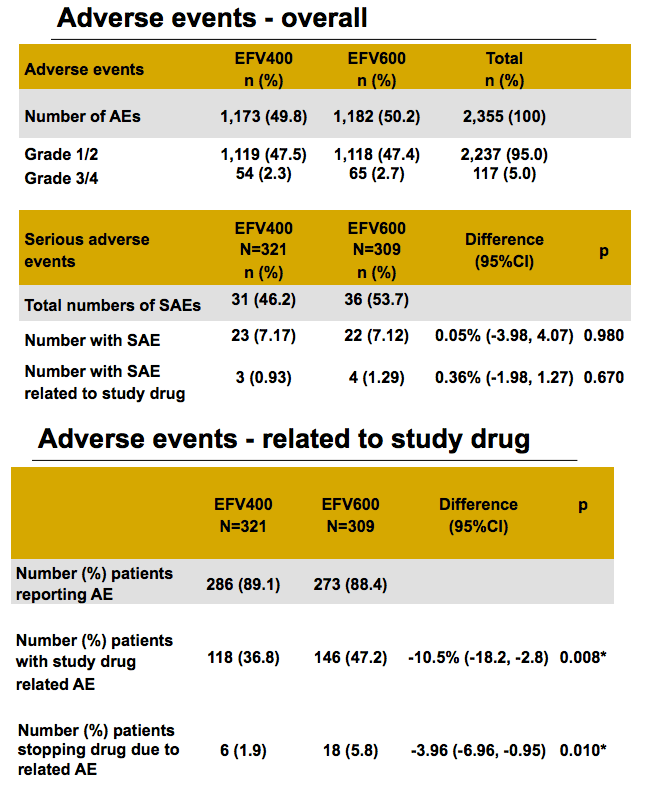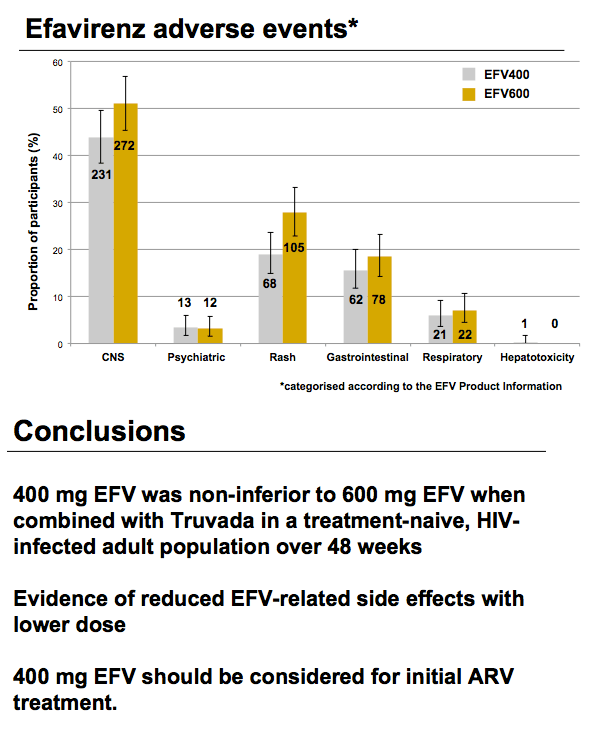 |
 |
 |
| |
Low-Dose (400-mg) Efavirenz vs Standard 600-mg Dose Studied, Found Non-Inferior
Low-Dose (400-mg) Efavirenz Not Inferior to Standard 600-mg Dose
|
| |
| |
7th IAS Conference on HIV Pathogenesis, Treatment and Prevention, June 30-July 3, 2013, Kuala Lumpur
Mark Mascolini
Two thirds the standard dose of efavirenz proved virologically noninferior to the standard dose in a 48-week trial with participants from Africa, Asia, Australia, Europe, and the Americas [1]. Some (but not all) evidence indicated a lower side-effect rate with 400 mg in this 600-person study.
The World Health Organization recommends efavirenz for first-line therapy, and the nonnucleoside is widely used across the globe. A lower dose could cut costs and perhaps make efavirenz more accessible and more tolerable. Previous phase 2 and observational cohort data suggested that doses below 600 mg daily can control HIV.
Encore1 is a randomized, double-blind, placebo-controlled trial in antiretroviral-naive adults without AIDS, with a viral load above 1000 copies, and with a CD4 count between 50 and 500. Researchers randomized them to 400 or 600 mg of efavirenz daily, both with tenofovir/emtricitabine. The investigators calculated that they needed 630 trial participants to demonstrate noninferiority of 400 mg. They randomized 324 people to the 400-mg dose and 312 to 600 mg in Asia, Africa, Australia, Europe, South America, and Mexico.
Study participants averaged 36 years in age and one third were women. Trial participation was divided between Africans (37%), Asians (33%), and Caucasians (30%). Median pretreatment viral load stood around 56,000 copies, and pretreatment CD4 count averaged 273.
Three analyses of proportions with a viral load below 200 copies at week 48 indicated that 400 mg of efavirenz once daily is noninferior to 600 mg:
400 vs 600 mg of efavirenz daily:
Missing-data-equal-failure analysis: 94.1% versus 92.2%, P = 0.36
Noncompleter-equals-failure analysis: 90.0% versus 85.8%, P = 0.10
Per-protocol analysis: 98.3% versus 97.4%, P = 0.47
Repeating these analyses in people with a pretreatment viral load above or below 100,000 copies showed no 48-week response difference between doses. The investigators did not report virologic response at the 50-copy cutoff used in most antiretroviral trials enrolling previously untreated people.
Researchers counted 32 failures in the 400-mg arm and 44 in the 600-mg arm (10.0% versus 14.2%), including 5 people on 400 mg and 7 people on 600 mg with a viral load above 200 copies (1.6% versus 2.3%) and 1 versus 2 (0.3% versus 0.6%) who stopped efavirenz because of virologic failure.
People in the 400-mg arm gained an average 25 more CD4 cells through 48 weeks, a significant difference (P = 0.009).
Adverse event rates were similar in the two study arms by certain measures, including grade 3 or 4 events (2.3% with 400 mg and 2.7% with 600 mg), serious adverse events (7.17% and 7.12%), and serious adverse events related to study drug (0.93% versus 1.29%). But a significantly lower proportion of people in the 400-mg arm stopped efavirenz because of an adverse event (1.9% versus 5.8%, P = 0.010). The researchers did not report rates of central nervous system side effects.
The Encore1 investigators concluded that the 400-mg dose "should be considered for initial antiretroviral treatment."
The researchers did not present adherence findings or pharmacokinetic data showing proportions of study participants who maintained an adequate efavirenz trough during the trial. Among people not enrolled in a clinical trial, with its strict follow-up and monitoring standards, adherence may not be as good. Also, HIV-positive taking rifampin for TB may not be good candidates for low-dose efavirenz because rifampin lowers efavirenz concentrations. Genotypic variations can also have a strong impact on efavirenz levels.
An earlier modeling study of the effectiveness of 400-mg efavirenz led the investigators to conclude that a 400-mg dose requires greater than 90% adherence to be effective, and they proposed that "this is an unrealistic expectation in the real world, but a possibility in clinical trials" [2]. But Encore1 was conducted in middle-income countries throughout the world, and further analysis of trial data may quash modeling concerns.
References
1. Puls R, Encore1 Study Group. A daily dose of 400mg efavirenz (EFV) is non-inferior to the standard 600mg dose: week 48 data from the ENCORE1 study, a randomised, double-blind, placebo controlled, non-inferiority trial. 7th IAS Conference on HIV Pathogenesis, Treatment and Prevention, June 30-July 3, 2013, Kuala Lumpur. Abstract WELBB01.
2. Fors J, Blaschke TF, Savic RM. Clinical trial simulations of effectiveness of reduced-dose efavirenz therapy: impact of adherence, pharmacogenetics and rifampin co-administration. 14th International Workshop on Clinical Pharmacology and HIV Therapy. April 22-24, 2013. Amsterdam. Abstract O_12.
----------------------------
Link to webcast:
http://pag.ias2013.org/flash.aspx?pid=612







|
| |
|
 |
 |
|
|